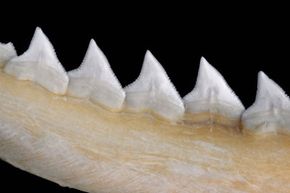Bull Shark Hunting and Feeding
If we're going to talk about the bull shark's diet, we need to break it up into the freshwater menu and the saltwater menu. When ocean-bound, bulls eat bony fish, stingrays, dolphins, sea turtles, other sharks, mollusks, crustaceans and all kinds of other schooling fish. They hunt alone, instead of in groups, and although they appear slow as they troll the ocean floor, they're known for their agility and quick bursts of speed -- up to 11 miles per hour. This may not sound too quick, but when you see a 10-foot shark coming your way at that speed, you may rethink your definition of fast. They're also not afraid to pick on someone their own size or even larger, something most other sharks won't do.
When the bulls hit freshwater, their diet gets a little more interesting. They feast on tarpon fish, crabs, shrimp, squid, sea urchins, turtles and sawfishes. Not interesting? How about birds, sloths, dogs, rats, cows and antelope? There have been reports in Australia of river-dwelling bulls eating horses, and in Mozambique, they feed on hippos. It's not exactly what you'd expect to find on a shark's menu, but bull sharks are opportunists -- they even eat their own kind if necessary.
Advertisement
The bull's hunting technique is known as the "bump and bite." This means that they will typically head-butt their prey before sinking their teeth into it. The bump is an investigative technique used to help the nearly blind shark figure out what it's about to bite. If you're scuba diving and get bumped by a bull shark, you're in trouble. Another technique the bull uses to make up for its poor vision is to hunt in murky water. Like other sharks, they're able to find their prey with their keen sense of smell. In shadowy waters, bulls can sniff out prey that can't see its approaching predator.
For more information on shark and other sea life, please see the links on the following page.
Related HowStuffWorks Articles
- How Whales Work
- How Sharks Work
- How Shark Attacks Work
- 15 Tips for Surviving a Shark Attack
- Why do people collect shark teeth?
- Inside 'Shark Tale'
- How do sharks smell, hear and see?
- How Tiger Sharks Work
- Shark Quiz
- Tiger Shark Quiz
- Great White Shark Quiz
More Great Links
Sources
- "Bull Shark (Carcharhinus leucas)."conservationinstitute.org, 2008. http://conservationinstitute.org/ocean_change/predation/bullshark.htm
- "Bull Shark Profile." nationalgeographic.com, 2008. http://animals.nationalgeographic.com/animals/fish/bull-shark.html
- "Bull Shark: Carcharhinus leucas Valenciennes, 1839." austmus.gov, 2008. http://www.austmus.gov.au/fishes/fishfacts/fish/cleucas.htm
- "Bull Sharks." apexpredators.com, 2008. http://www.apexpredators.com/bullsharks.asp
- "Carcharhinus leucas." University of Michigan Museum of Zoology, 2008. http://animaldiversity.ummz.umich.edu/site/accounts/information/Carcharhinus_leucas.html
- "Carcharhinus leucas: Bull Shark." marinebio.org, 2008. http://marinebio.org/species.asp?id=83
- "Freshwater Sharks and Rays." elasmo-research.org, 2008. http://www.elasmo-research.org/education/topics/p_fw_rays.htm
- "Icthyology at the Florida Museum of Natural History." Florida Museum of Natural History, 2008. http://www.flmnh.ufl.edu/fish/gallery/Descript/bullshark/bullshark.htm McCollam, Douglas. "The Bull Shark." slate.com, July 18, 2001. http://www.slate.com/id/112116/
- "IUCN Red List of Threatened Species." iucnredlist.org, 2008. http://www.iucnredlist.org/search/details.php/39372/summ
- "NOAA Fisheries Fact Sheet." noaa.gov, 2008. http://www.nmfs.noaa.gov/sharks/FS_bullshark.htm
- "Recognizing Shark Species." sharksurvivor.com, 2008. http://sharksurvivor.com/sharks/bullshark.htm
- Handwerk, Brian. "Bull Shark Threat: They Swim Where We Swim." National Geographic News, July 19, 2005. http://news.nationalgeographic.com/news/2005/07/0719_050719_bullsharks.html
- Van Sant, Will. "Bull shark caught off local dock." St. Petersburg Times, June 4, 2007. http://www.sptimes.com/2007/06/04/Southpinellas/Bull_shark_caught_off.shtml
